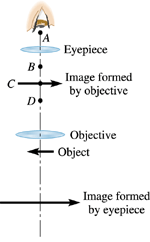 |
| 1 |  | 
A magnifying glass can be held over a piece of white paper and its position adjusted until the image of an overhead light is formed on the paper. Explain. |
|  | |
|
|
 |
| 2 |  | 
Why is a refracting telescope with a large angular magnification longer than one with a smaller magnification? |
|  | |
|
|
 |
| 3 |  | 
Why do some telescopes produce an inverted image? |
|  | |
|
|
 |
| 4 |  | 
Two magnifying glasses are labeled with their angular magnifications. Glass A has a magnification of "2X" (M = 2) and glass B has a magnification of 4X. Which has the longer focal length? Explain. |
|  | |
|
|
 |
| 5 |  | 
A converging lens and a diverging lens, separated by a distance of 30.0 cm, are used in combination. The converging lens has a focal length of 15.0 cm. The diverging lens is of unknown focal length. An object is placed 20.0 cm in front of the converging lens; the final image is virtual and is formed 12.0 cm before the diverging lens. What is the focal length of the diverging lens? |
|  | |
|
|
 |
| 6 |  | 
A photographer wishes to take a photograph of the Eiffel Tower (300 m tall) from across the Seine River, a distance of 300 m from the tower. What focal length lens should she use to get an image that is 20 mm high on the film? |
|  | |
|
|
 |
| 7 |  | 
A slide projector has a lens of focal length 12 cm. Each slide is 24 mm by 36 mm (see Fig. 24.24). The projector is used in a room where the screen is 5.0 m from the projector. How large must the screen be?
 <a onClick="window.open('/olcweb/cgi/pluginpop.cgi?it=gif::Fig. 24.24::/sites/dl/free/0070524076/58007/24_024.gif','popWin', 'width=NaN,height=NaN,resizable,scrollbars');" href="#"><img valign="absmiddle" height="16" width="16" border="0" src="/olcweb/styles/shared/linkicons/image.gif">Fig. 24.24 (6.0K)</a>Fig. 24.24 <a onClick="window.open('/olcweb/cgi/pluginpop.cgi?it=gif::Fig. 24.24::/sites/dl/free/0070524076/58007/24_024.gif','popWin', 'width=NaN,height=NaN,resizable,scrollbars');" href="#"><img valign="absmiddle" height="16" width="16" border="0" src="/olcweb/styles/shared/linkicons/image.gif">Fig. 24.24 (6.0K)</a>Fig. 24.24 |
|  | |
|
|
 |
| 8 |  | 
The uncorrected far point of Charlotte's eye is 2.0 m. What refractive power contact lens enables her to clearly distinguish objects at large distances? |
|  | |
|
|
 |
| 9 |  | 
Keesha is looking at a beetle with a magnifying glass. She wants to see an upright, enlarged image at a distance of 25 cm. The focal length of the magnifying glass is +5.0 cm. Assume that Keesha's eye is close to the magnifying glass. (a) What should be the distance between the magnifying glass and the beetle? (b) What is the angular magnification? |
|  | |
|
|
 |
| 10 |  | 
An insect that is 5.00 mm long is placed 10.0 cm from a converging lens with a focal length of 12.0 cm. (a) What is the position of the image? (b) What is the size of the image? (c) Is the image upright or inverted? (d) Is the image real or virtual? (e) What is the angular magnification if the lens is close to the eye? |
|  | |
|
|
 |
| 11 |  | 
Figure 24.25 shows a schematic diagram of a microscope. For the object and image locations shown, which of the points (A, B, C, or D) represents a focal point of the eyepiece? Draw a ray diagram.
 <a onClick="window.open('/olcweb/cgi/pluginpop.cgi?it=gif::Fig. 24.25::/sites/dl/free/0070524076/58007/24_025.gif','popWin', 'width=NaN,height=NaN,resizable,scrollbars');" href="#"><img valign="absmiddle" height="16" width="16" border="0" src="/olcweb/styles/shared/linkicons/image.gif">Fig. 24.25 (7.0K)</a>Fig. 24.25 <a onClick="window.open('/olcweb/cgi/pluginpop.cgi?it=gif::Fig. 24.25::/sites/dl/free/0070524076/58007/24_025.gif','popWin', 'width=NaN,height=NaN,resizable,scrollbars');" href="#"><img valign="absmiddle" height="16" width="16" border="0" src="/olcweb/styles/shared/linkicons/image.gif">Fig. 24.25 (7.0K)</a>Fig. 24.25 |
|  | |
|
|
 |
| 12 |  | 
The objective lens of an astronomical telescope forms an image of a distant object at the focal point of the eyepiece, which has a focal length of 5.0 cm. If the two lenses are 45.0 cm apart, what is the angular magnification? |
|  | |
|
|
 |
| 13 |  | 
A dissecting microscope is designed to have a large distance between the object and the objective lens. Suppose the focal length of the objective of a dissecting microscope is 5.0 cm, the focal length of the eyepiece is 4.0 cm, and the distance between the lenses is 32.0 cm. (a) What is the distance between the object and the objective lens? (b) What is the angular magnification? |
|  | |
|
|
 |
| 14 |  | 
A refracting telescope has an objective lens with a focal length of 2.20 m and an eyepiece with a focal length of 1.5 cm. If you look through this telescope the wrong way, that is, with your eye placed at the objective lens, by what factor is the angular size of an observed object reduced? |
|  | |
|
|

